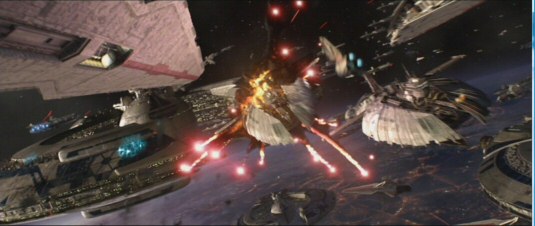Lots of science fiction has huge space battles in. In many ways, all that monkeying around with plot, characters and storyline is just foreplay for big fleets of impossibly large space battleships to blast away at each other and go bang.
I applaud this initiative.
And I understand, as someone making entertainment, that so much in the classic sci-fi space battle is bullshit. There are no laser sounds in space. No ship, regardless of damage ever loses its artificial gravity etc etc. This doesn’t bother me, because I’m making a not-too-serious fun battle game, so my lasers will go zap and fizz just like the rest of them.
What I’m more interested, because of the strategy nature of my game, is the actual mechanics of the battles. Take (for example) the big space battle at the start of Revenge of the Sith:

There seem to be some nice huge battleships here blasting the hell out of each other at extremely close range, and lost of tiny fighters flying around going zap zap too. The thing that interests me is the economics of it all. Why can’t side A field a fleet of 50,000 fighter/bombers instead of a nice aesthetically balanced fleet of 10 huge capital ships, 50 average ones and 200 fighters. Each of those capital ships is maybe 5,000 times the size of a one man fighter, and must cost 5,000 times as much to build.
Is it because the fighter’s lasers can’t penetrate the armour of the bigger ships at all? Do they need carriers to get them between systems? do they need refuelling? And given that the fighters fly at 100 times the speed of the bigger ships, how the hell isn’t the fighter vs fighter battle over long before a single capital ship gets within firing range of an enemy capital ship?
These are the questions which currently keep me awake at night, because I’m trying to design a set of spaceship and fleet construction rules that allow you to have lots of freedom, yet still ensure you end up building a fleet of disparate size ships that look good in space battles :D.